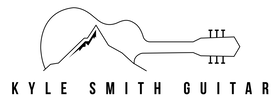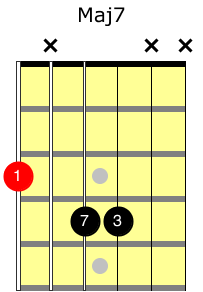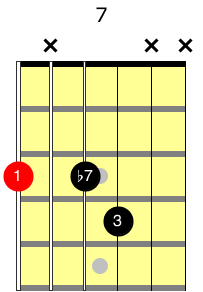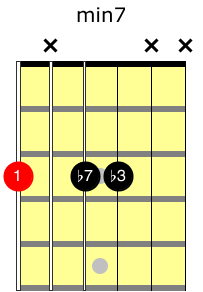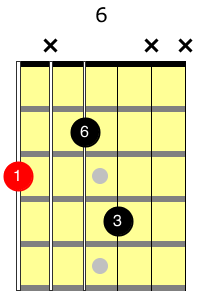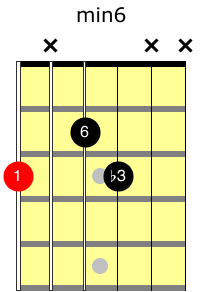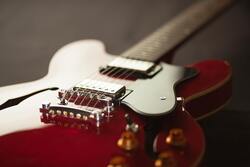 When you’re just getting started in jazz guitar, learning the right kinds of chords is probably going to be your top priority. Whether you’re playing in a school jazz band or you’re interested in jazz guitar to pick up a new style for yourself, knowing the right types of chords is an essential element of your jazz guitar playing. That’s where the chords in this lesson come in. With these simple 3 note chords starting on the 6th string, you’ll be able to create the basic structure for any jazz guitar chord you need. These chords are a great starting point for learning jazz guitar - they are easy to learn, easy to play, and they sound good. In this lesson you’re going to learn the basic 3 note jazz guitar chord shape starting on the 6th string. You’ll also learn how to change this shape to create any chord you need using basic music theory rules. 3 Note Chords For Jazz GuitarHere we are learning some basic 3 note jazz guitar chords that will help simplify the learning process for you. These chords have 3 essential structural notes of each chord - the root (1), the third (3), and the seventh (7). Here’s why these notes are important:
Together these three notes give you the tools you need in order to get started playing jazz guitar chords that will sound good, and build a foundation for more colorful chords in the future. The really nice thing about these chords is that they are movable shapes or forms. You can learn to play a 7th chord once, and then you technically know the 7th chord in every key. Since the root for these chords is on the 6th string, you just need to learn the notes on the 6th string and you’ll always know what chord you’re playing. Need help learning the notes on the 6th string? Click here to get started. Sometimes these chords are called “shell voicings” - because they don’t have the 5th of the chord, they won’t conflict with a piano player, big band horn section, or a soloist. These jazz guitar chords will give you everything you need at a basic level, they’re easy to learn, and they sound good. 6th String Chord StructureThese chords are going to use what I call a 6th string chord structure, or 6th string form. The notes of the chord (chord tones) that we are going to use are the root (1), the seventh (7), and the third (3), in that order from lowest to highest note. No matter what type of chord we create that structure will be the same - root on the bottom, the seventh above that, and the third above that. Primary Chord Shapes:Major 7th ChordThe major 7th chord is built 1 7 3 for this chord shape. Playing recommendation: You can strum it - just be careful to only hit strings that have a finger on them - these are 3 note chords
Common Chord Symbols: (assuming a G root - 6th string, 3rd fret)
To Practice:
Dominant 7th Chord
Playing recommendation
Common Chord Symbols: (assuming a G root - 6th string, 3rd fret)
To Practice:
Minor 7th ChordThe minor 7th chord is built 1 b7 b3 for this chord shape.
Playing recommendation:
Common Chord Symbols: (assuming a G root - 6th string, 3rd fret)
To Practice:
Bonus Chord Shapes - 6th ChordsLearning 6th chords can be really useful for your jazz guitar playing because both the major and the minor 6th chords can serve more than one function without adding any extra notes. The basic structure of these chords is the same as the 7th chords, but the 6th replaces the 7th as a chord tone. If you are comfortable with your major, dominant, and minor 7th chords, these will be easy for you to learn and use. Major 6th ChordThe major 6th chord is built 1 6 3 for this chord shape. Playing recommendation:
Common Chord Symbols: (assuming a G root - 6th string, 3rd fret)
Extra Uses:
To Practice:
Minor 6th ChordThe minor 6th chord is built 1 6 b3 for this chord shape.
Playing recommendation:
Common Chord Symbols: (assuming a G root - 6th string, 3rd fret)
Extra Uses:
To Practice:
Things To Think About: Learning these easy jazz guitar chords will help you build any chord you need in the course of playing jazz songs. They are easy to learn, they sound good, and they let you play jazz chords that work for a lot of musical situations. Keep practicing these 3 note chords, and try to apply them to jazz songs as soon as possible. Remember that these are movable chords, so if you learn the notes along the 6th string, you can play any chord in any key. Try to get comfortable with these chords, and let me know how it goes. If you have any questions or need help, click here to contact me. I’m always happy to help! Related Guitar LessonsI hope you enjoyed this lesson. Here are a couple of related guitar lessons that you might find helpful: Jazz Guitar LessonsAre you looking for jazz guitar lessons? I can help you with jazz guitar lessons in Portland Oregon, or online. All jazz guitar lessons are one on one, so you get help with exactly what you need and want. Click the links below to learn more about: Contact me today to learn more and book a lesson when you're ready!
0 Comments
Your comment will be posted after it is approved.
Leave a Reply. |
